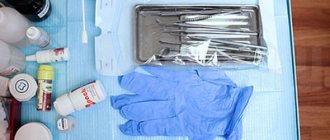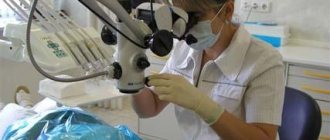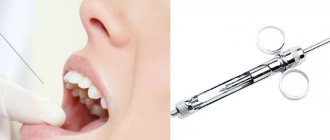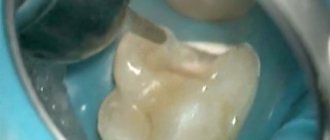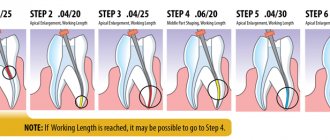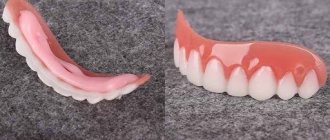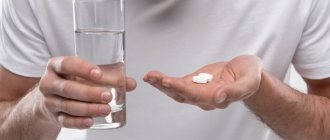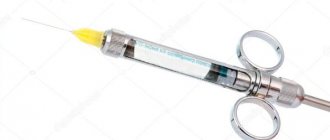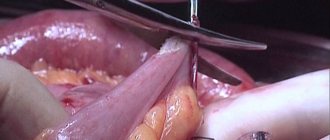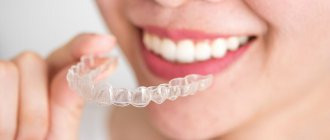What is carpule anesthesia?
Carpule anesthesia in dentistry is an injection anesthesia using a special syringe, which is called a carpule.
The use of a carpule syringe increases the safety and comfort of anesthesia.
That is, carpule anesthesia in dentistry can be of any type - the main thing is that a carpule syringe and the carpule itself with an anesthetic are used.
Storage conditions
The transfer of the technology for the production of anesthetic substances to factory conditions has led to the emergence of guarantees of tightness and sterility of the drug manufacturing process. The spread of carpule instruments made it possible to transfer responsibility for the quality of the administered medicine from doctors to syringe manufacturers.
During procedures, the dentist is required to comply with the following strict rules:
- The anesthetic substance must have permission for use from the Pharmacological Committee of the Russian Ministry of Health.
- The product must be equipped with quality documents, which is confirmed by receiving an expert assessment from specialists.
- Drug labeling must be printed on each unit of product.
- Particular attention must be paid to the expiration date, since the use of expired substances is not allowed.
When storing painkillers, it is necessary to avoid sources of heat and light, that is, carpules should be stored in dry, dark rooms at a temperature no higher than +25°.
During storage of carpules, the following situations may arise:
- The cartridges were frozen and then thawed further. In this case, it is likely that air will enter the cartridge and form bubbles that push the plunger out.
- Small bubbles, which are observed when the plunger plug is intact, can form through the accumulation of nitrogen, which is used to prevent oxygen from penetrating into the capsule. This drug can be used.
- The appearance of rust on the plug proves that the integrity of the cartridge has been damaged.
- A change in the color properties and density of a substance indicates transformations in its chemical formula due to improper preservation.
The needles should also be kept in a place away from sources of moisture, light and heat. The integrity of the packaging must be protected. It is prohibited to use needles that have expired. The devices should be removed from the packaging immediately before the procedure and kept closed with a plastic cap.
Equipment
Essentially, a carpule syringe is a metal dental anesthesia syringe that can be used many times and is sterilized in the same way as other dental instruments. A carpule with an anesthetic is inserted into the carpule syringe - a special glass cartridge, factory-made.
Currently, the Trilogy Medical and Dental Center uses carpule syringes for injection anesthesia - they are much more convenient and more sophisticated than conventional disposable syringes.
Flaws
The large list of advantages of this type of anesthesia does not exclude the presence of certain disadvantages.
The biggest disadvantage is the high cost of syringes. The production of such complex structures is expensive. The higher the quality of the tool, the higher its cost.
The second significant disadvantage of carpule anesthesia is the lack of possibility of modifying the used anesthetic with the help of a vasoconstrictor.
The ampoule with a solution of the substance is hermetically sealed and if opened, it will become unsuitable for use.
Advantages of carpule pain relief
The most important advantages of carpulal anesthesia can be considered:
- The exact amount of the drug in 1 ampoule is exactly 1.7 ml. Thanks to this, the doctor can count the carpules and know exactly the dosage of the administered drug.
- Complete sterility. Carpules are manufactured and sealed in a warehouse under completely sterile conditions. This way you can be sure of the quality of the injected drug.
- Less pain from the injection itself. Patients feel less pain when punctured because the needle of a carpule syringe is much thinner and more flexible than that of a regular syringe.
- It is more convenient for the doctor to control the process. The dental anesthesia carpule syringe fits very comfortably in the hand thanks to special handles and stops. Also due to the greater flexibility of the needle, it can be bent in almost any direction without fear of it breaking off.
- Elimination of errors. When using Carpules, the possibility that the doctor will administer the wrong drug or in the wrong quantity or concentration is completely eliminated. After all, with carpule anesthesia, the doctor always knows exactly what he is injecting - the name of the drug, its concentration and quantity is written on each carpule.
Syringe selection
When selecting a suitable syringe, the following important rules must be observed:
- When purchasing, you should take into account that most likely you will have to install needles from different manufacturers into the tool, so it is necessary that a spare clamp attachment is included with the device.
- The syringe must have the characteristics of convenience and aesthetic appeal (so as not to frighten patients).
- The body of the device must have increased strength, which allows the drug to be administered for pain relief under greater pressure.
- The dentist should use the syringe easily (with one hand).
- The device must be suitable for performing an aspiration test, which can prevent inadvertent injection of the substance into the blood vessels.
- When using the instrument on children, experts recommend purchasing auxiliary bright attachments for the device that disguise it, turning the therapy process into a game.
A reusable carpule syringe in dentistry manufactured by Anthogyr (France) is made of tool metal (steel) and often includes a spare clamp attachment. The product is characterized by ease of use and quality parameters.
Carpule syringes of the Asa Dental brand (Italy) are made of chrome-plated steel and are distinguished by a variety of models:
- number of rings;
- aspiration method;
- ergonomics and appearance;
- carpool fastening method.
Pakistani-made syringes (MEDENTA brand) are lower in cost compared to similar instruments produced in the European Union. The products are made from a particularly light alloy with a corrosion-resistant coating.
The design of the device provides for a large visibility window, which allows you to control the progress of aspiration. The model range includes a variety of products in appearance; there are various variations of replaceable tips.
Disadvantages of carpule anesthesia
Despite the minor disadvantages described below, carpule anesthesia in dentistry is currently considered the safest and most modern option for injecting an anesthetic.
- Higher price of equipment.
Carpule syringes are more expensive per unit than disposable syringes. This is due to the fact that syringes with carpules for anesthesia in dentistry are quite complex in design, plus really high-quality ones will cost more than simpler options.
- It is impossible to change the concentration of anesthetic inside the cartridge - the cartridge is completely sealed and it is not possible to add anything inside.
Selection of carpule needles
The carpule needle consists of a metal nozzle and a plastic coupling, with the help of which the spear is attached to the body. The product must guarantee effortless, painless injection of the medicinal substance.
It has 2 sides, with the help of which manipulations become harmless. The elongated side of the tip is used to penetrate dental tissues; it ends with a chamfer. The short side is a device for opening impenetrable carpules.
The criteria for selecting a device should be based on the following characteristics:
- Dentists recommend choosing a product that has a red mark indicating the direction of movement of the syringe. This can increase the level of medical manipulations and reduce the time a person spends in the dental chair.
- The metal for the manufacture of products is selected according to the parameters of thickness, reliability, and increased elasticity. This will help avoid infection and eliminate discomfort during the procedure, providing opportunities to reach the most inaccessible places in the oral cavity.
- Needles are selected according to length. There are products on sale with lengths from 10 to 25.5 mm (short) and 28.9-41.5 mm (long).
- Dentists also select needles based on diameter.
Foreign-made needles are more expensive; they are certified to European and American standards. The most expensive products include products from the company Septoject Evolution (a package of 100 pieces can cost 1000-1400 rubles), made from high quality metal.
Products made in Korea and Pakistan are much cheaper (300-500 rubles), which are also of good quality (brands NI-PRO, BIODENT, Sun Pharmaceuticals, Cornerstone Corporation). The cheapest needles will cost you Russian-made needles (AERS), which are not inferior in quality to their foreign counterparts.
All manufacturing companies produce products according to standard parameters of diameter and length: 12, 16, 21, 25, 30, 35, 38 mm.
Conditions that local anesthetics must adhere to
In general, local anesthetics should:
- Do not cause allergies
- Have minimal toxicity to the body
- Have few side effects
- Easy to dissolve and excrete
In addition to this, anesthetic agents are required to:
- The effect is strong enough to completely anesthetize the tooth and surrounding tissues.
- Rapid numbness - no more than 5 minutes after the injection
- The numbness should last at least an hour - so that it is enough for the entire procedure, including the very last manipulations
- Anesthesia should take place no more than 2-3 hours later.
- Long-term stability of the drug itself – at least 2–3 years
How to distinguish an original from a fake?
Karpula ensures the sterility of chemical compounds. It also serves to create the necessary pressure in the syringe, which is required during the aspiration test procedure.
The capsule is a cylindrical container made of glass or plastic with a silicone piston placed at one end and a rubber stopper covered with metal at the other end. The inside volume of the cartridge should be 2 ml. However, due to the presence of a stopper, the capacity can be reduced to 1.7-1.8 ml.
Due to incorrect transportation, storage, or the purchase of counterfeits, changes in the presentation of capsules or boxes may occur, which you should pay attention to:
- discrepancy between the color characteristics and density of the substance (yellowness, turbidity, sediment);
- the position of the piston does not correspond to the dimensions of the cartridge, however, bubbles may be observed in the middle of the capsule;
- rust is detected on the cartridge (seal failure);
- The boxes show signs of being dented or have any defects.
When choosing needles, you need to pay attention to the presence of certain quality characteristics that are adhered to by well-known pharmaceutical companies:
- Branded products have a red mark on the outside of the body (on the cut side of the tip).
- Certified products have a thread on the inside of the body into which a syringe of the appropriate size and shape is screwed, according to the type of device.
- Manufacturers package original needles in packages of 100 pieces.
- After sterilization at the factory, the cases are sealed with paper seals or using cutters.
- The labels must clearly indicate the manufacturer's data (location, name), needle marking (length, diameter), production time and shelf life of the product.
The best anesthetic – does it exist?
As we said above, almost all modern anesthetics are made on the basis of articaine, so there is not such a fundamental difference between them. Most patients are anesthetized with Ultracaine or Ubestezin.
But we must also take into account that, of course, it is important what is injected, but it is also important how it is done - a lot depends on the doctor and the technique of performing anesthesia.
Indications, contraindications and consequences of carpules anesthesia depend more on the type of anesthesia - infiltration or conduction, than specifically on the carpules. But, as we noted earlier, with carpule anesthesia there is no risk of administering the wrong drug and there is virtually no risk of the needle breaking off.
Contents of the drug
Knowledge of the chemical composition is a prerequisite when using any product, and capsule painkillers cannot be considered an exception to this rule. Detailed information is provided on the packaging, and contains not only a list of names, but also the proportional presence of each component. The injector contains:
- An anesthetic is a substance that reduces the pain threshold to a minimum, making it possible to carry out medical manipulations in the problem area of the jaw. Such compounds belong to the category of amides and elements derived from them - examples usually include Lidocaine, articaine, prilocaine, etc.
- Vasoconstrictor is a stimulator of processes that constrict blood vessels and prolong the arrest of nerve endings. Increases the duration of the effect achieved as a result of the injection, and also prevents premature leaching from the working area. Provides for strict operating restrictions, and requires caution when used to treat patients suffering from chronic heart pathologies, diabetes, age-related changes, etc.
- Antioxidants – bisulfites and sodium sulfites, which prevent the destruction of the vasoconstrictor due to the influence of oxygen from the environment. They can provoke an allergic reaction, which also necessitates the patient undergoing preliminary diagnostics and studying the medical history.
- EDTA, parabens and preservatives are substances that ensure metal bonding, sterility of the capsule contents and preservation of the functional properties of the drug.
Thanks to this balanced composition, the anesthetic is reliably protected from the penetration of pathogenic microorganisms. The main requirement related to the specifics of the carpule anesthetic is to make sure before using the medication that the patient is not allergic to its derivatives and active components.
Conduction anesthesia in pregnant women and children
Frequent visitors to dental offices are pregnant women. Since the growing orgasm requires a lot of calcium, the teeth of the expectant mother often suffer. Conductive anesthesia is given to pregnant women only for complex manipulations (tooth extraction, treatment of severe caries or multiple dental lesions).
Doctors choose Lidocaine as an anesthetic for pregnant women. It effectively anesthetizes the desired area and is quickly eliminated from the body, without causing harm to either the mother’s body or the unborn baby. Ketamine is not recommended in the early stages, as it can increase the tone of the uterus, which can lead to spontaneous abortion. When the patient is overcome by severe pain, Promedol can be used. It quickly and strongly relieves pain in the jaw, having less dangerous properties.
When treating teeth in children under three years of age, conduction anesthesia is rarely used. The procedure in this case will differ from the traditional scheme, since in children the jaw structure is not the same as in adult patients. The administration of anesthesia in older people also has its differences.
Features of conduction anesthesia
This type of anesthesia involves the administration of an anesthetic through an injection into a place near the nerve that innervates (supplies nerves) the area of the oral cavity being operated on. Thus, sensitivity is blocked.
This type of anesthesia is considered preferable in dentistry because it has a small list of possible side effects. Strong conduction anesthesia relieves pain for 6-8 hours, while less aggressive anesthesia is used in dentistry.
Conduction anesthesia is in no way inferior to other methods of pain relief in dentistry. There are separate types of anesthesia for the upper and lower jaws, which take into account the location of the nerves in different areas.
To anesthetize the upper jaw, infraorbital anesthesia is most often used, which involves injecting an anesthetic under the eyeball. Tuberal anesthesia is also used, which is carried out by injecting a solution into the tubercle of the upper jaw.
The lower jaw is desensitized through the apodactyl and intraoral routes. With the apodactylic method, the doctor does not touch the patient, but inserts a needle into the area of the outermost molar. Intraoral anesthesia involves feeling the puncture site.
Apodactyl methods of conduction anesthesia
- Verlotsky's method. The needle is inserted into the fold that appears when the pterygomandibular ligament is stretched. The insertion is carried out in the middle between the wisdom teeth.
- Weisbrem's method. The procedure involves injecting an anesthetic into the mandibular eminence. This elevation is located on the inner surface of the branch, just above the bone tongue.
- Kadochnikov's method. This type of anesthesia is recommended in cases where it is difficult to open the mouth. The mucosa is pierced with a long needle over the large retromolar triangle, advanced to the torus, deepened by 3-3.5 cm and an anesthetic is injected.
- Gau-Gate method. The needle is inserted into the medial zone of the medial ligament through the fatty cord. The solution is released into the neck of the condylar process. This way, all three branches of the nerve of the lower jaw are anesthetized.
- Akinozi method. The needle is inserted with the jaws closed into the maxillary edge of the gum. The anesthetic must enter the tissue of the arch between the maxillary tubercle and the ramus of the jaw. Slow introduction of the solution is required. Pain relief occurs due to diffusion (the main branches of the nerve are located very close to this area).
The lower jaw can be numbed externally. It is strictly forbidden to use methods of anesthesia of the upper jaw on the lower jaw and vice versa. When developing these methods, the peculiarities of the structure of each jaw and nerve bundles were taken into account.
Extraoral methods of conduction anesthesia
- Submandibular. Inserting a needle under the lower edge of the lower jaw. The mandibular nerves are anesthetized.
- Podzykulova. You can insert the needle in front of the wheel (under the zygomatic arch), at the level of the middle of the trago-orbital line, or in front of the articular tubercle under the zygomatic arch. This numbs the entire mandibular nerve near the foramen ovale.
- Postmaxillary. The needle is inserted a centimeter below the mastoid process near the posterior edge of the lower jaw. The disadvantage of this method is the need to pierce the parotid gland. Damage to a large vessel is also possible.
- Anteriormaxillary. The doctor inserts the needle into the medial surface of the branch, moves it to the corner of the mouth and deepens it by 1.5 cm.
Conduction anesthesia makes it possible to combine it with general or spinal anesthesia, when not only anesthesia is required, but also muscle relaxation.
Reasons for the lack of pain relief
There are often cases when anesthesia may not work. There is a likely risk of a weak analgesic effect or its complete absence.
The reasons for this phenomenon can be called:
- Excessive fear. Many people are terrified of visiting the dentist.
In this case, a psychological factor is triggered - a person subconsciously feels pain. The action of adrenaline may occur, which blocks the nerve endings, and the active substance does not pass to them. In this situation, it is recommended to take a sedative a couple of hours before visiting the dentist. - Addictive effect. There are often cases when a person’s body adapts to the effects of painkillers and does not respond to them. In this case, it is necessary to change the type of active component.
- The effect of alcohol. Due to fear of visiting the dentist, some people may drink alcohol before visiting the doctor. Its action reduces the effectiveness of anesthesia. In such cases, it is necessary to increase the dose of the drug several times.
Feelings during conduction anesthesia
The first sign of the effects of conduction anesthesia is slight muscle numbness and a feeling of heaviness. In dentistry, drugs and doses are used that can numb the area in a matter of minutes.
Peripheral nerve blockade using conduction anesthesia is almost 100% safe. The risk of infection remains, but it is minimized in conditions of absolute sterility. Also, a hematoma may appear at the puncture site due to damage to the vessel. This most often happens when the patient takes drugs that reduce blood clotting.
After treatment, the feeling of numbness persists. Sensitivity will remain absent for some time (depending on the patient's response to the drug). Some people do not respond well to anesthesia, and pain may occur during the procedure. You need to notify the doctor, he will give an additional injection.
The duration of the effect is individual for each patient. Complete lack of sensitivity sometimes lasts for hours. The risk of nerve damage is less than one percent.

